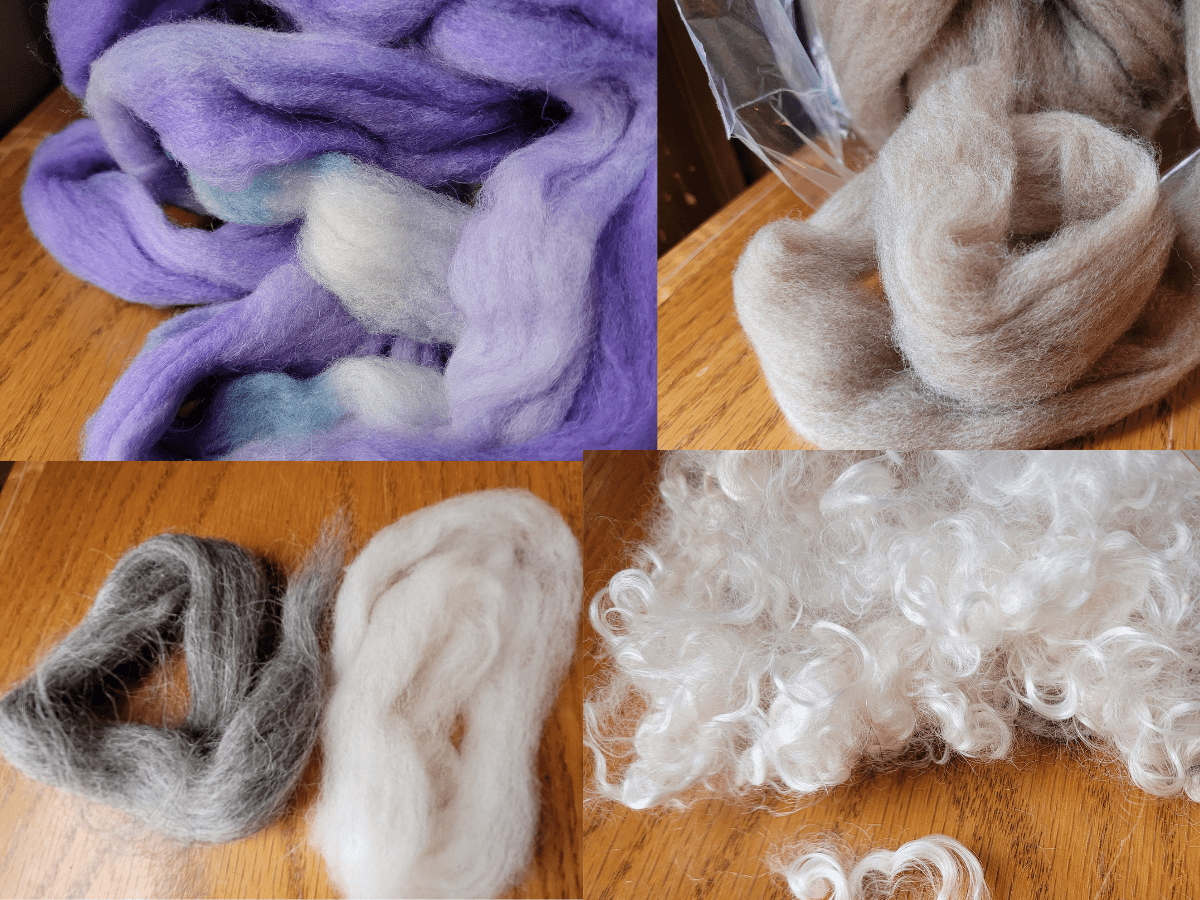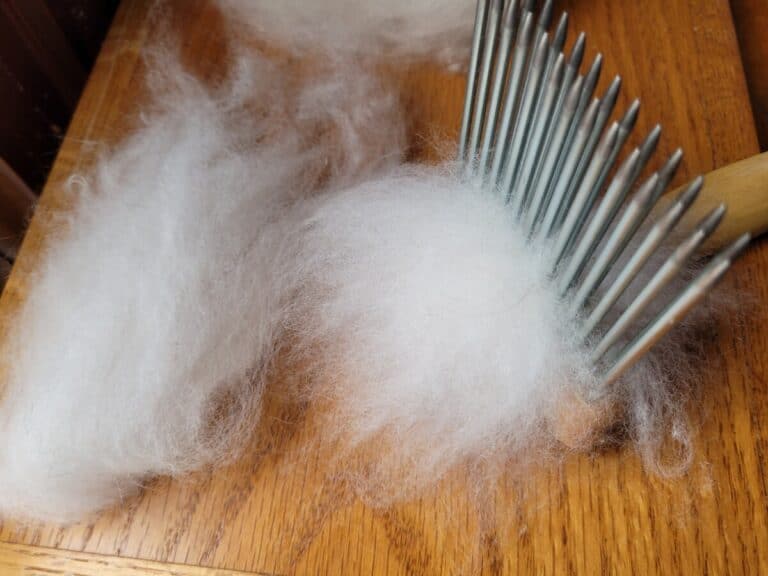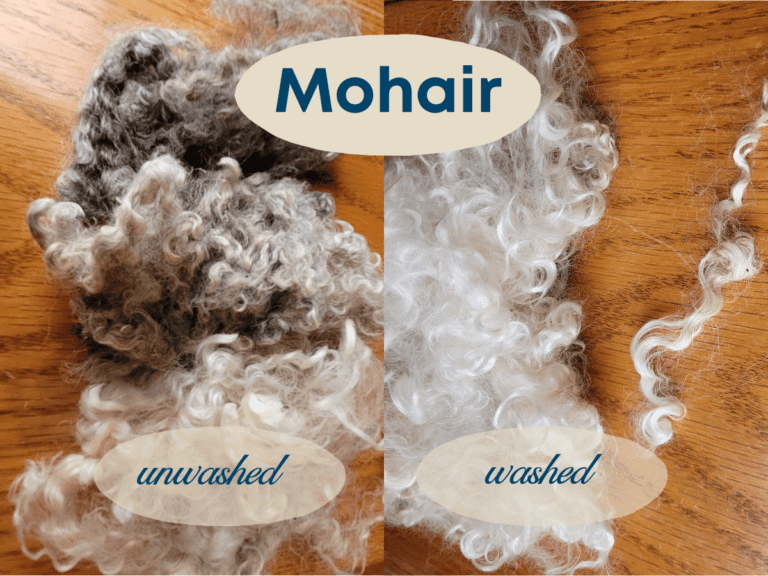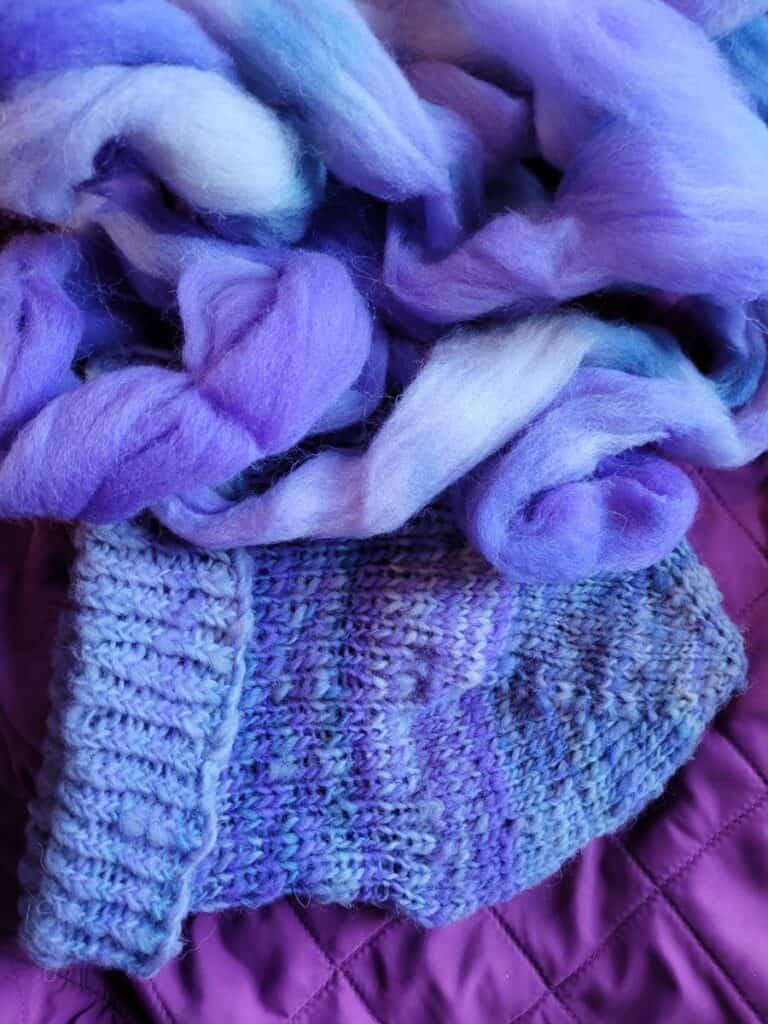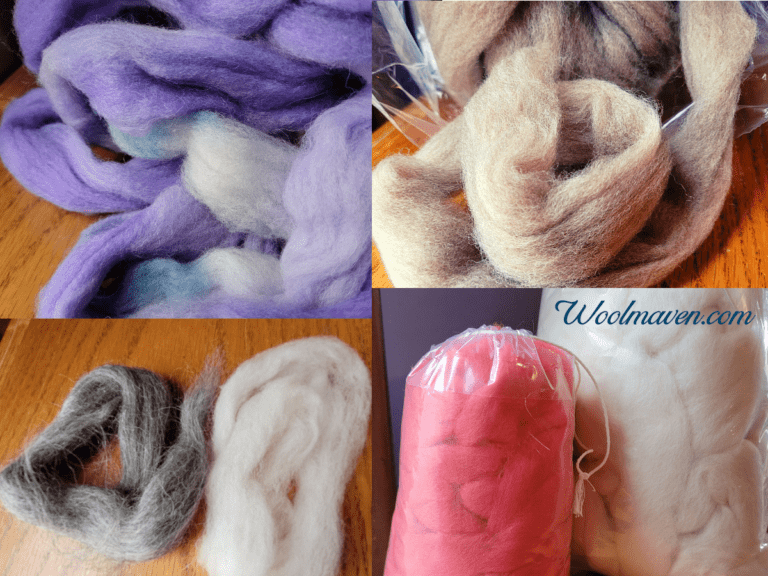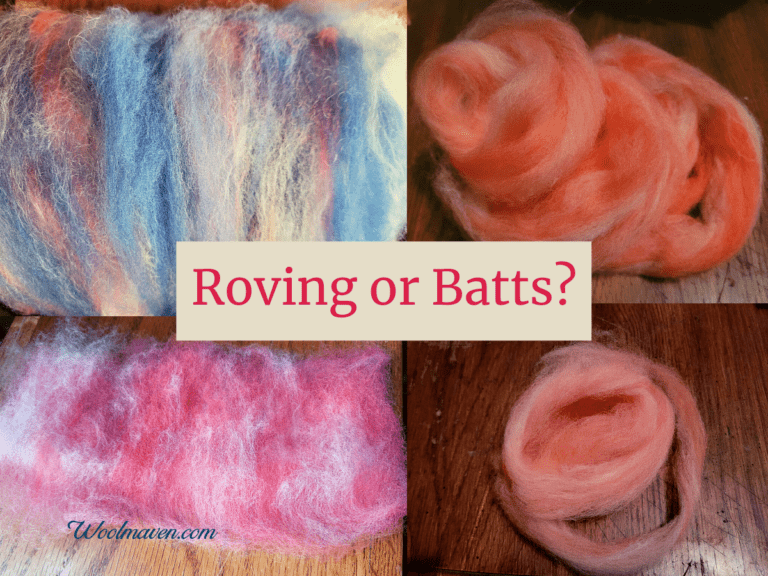How To Pick The Best Wool To Spin For Your Project
Each time you start a new project, you have to consider which wool will suit you the best.
The wool that was best for you as a beginner is probably not going to be the wool you use for the rest of your handspinning.
How do you pick the wool that is most likely to work for you and the project you have in mind, especially if you are a beginner?
The best wool to spin is determined by choosing the wool that matches your level of experience, your spinning style and your specifications for the wool craft project, including staple length, crimp, ease of spinning, feltability, dyeability and end use of the yarn. New handspinners should start with Corriedale roving or top.
Roving vs Combed Top goes over the pros and cons of each and helps you determine how to pick the one that suits you and your next project!
| Characteristic wanted | Wool suggestion |
| Most beginner friendly | Corriedale roving or top |
| Intermediate beginner friendly | Medium wools with 3-5 inch staple |
| Well defined, clearly shows patterns | worsted spun medium wool |
| Soft and warm | woolen spun fine wool |
| Sweater or hat friendly | medium wools |
| Next to skin soft | fine wools |
| Yarn with spring/bounce back | high crimp wools |
| Yarn with durability | medium and long wools |
| Yarn that has luster | long wools |
| Ability to resist felting | the down breeds |
| Popular fine wools | Merino, Rambouillet, Targhee |
| Popular medium wools | Corriedale, Falkland, Shetland, |
| Popular long wools | Blue Faced Leicester, Lincoln, Romney, |
This post contains affiliate links, which means I receive commissions if you choose to purchase through links I provide (at no extra cost to you).
Are you a beginner or more experienced handspinner?
If you are a beginner, go with ready to spin Corriedale top or roving and stick to it until you can make the yarn that you are happy with.
Corriedale is a popular wool for handspinners of all experience levels. You’ll be able to get in plenty of practice with reasonably priced and easy to find wool.
If you just need some color in your handspinnng life (and I’m with you!), consider going with a dyed Corriedale top or a humbug, which is a striped roving with white and natural colored wool.
This will give you a bit of fun, but keep you in the easy to spin world of Corriedale until you get in some mileage and can consider expanding your experience with other wools.
If you already have some experience but are still not solid on your spinning, consider branching out slightly with Romney. I think Romney is just as easy to spin as Corriedale, but is a bit harder to find.
9 Beginner Friendly Wools To Spin gives you a list of easy to use wools. If you are a rank beginner, stick to Corriedale and try these additional wools once you get in some practice.
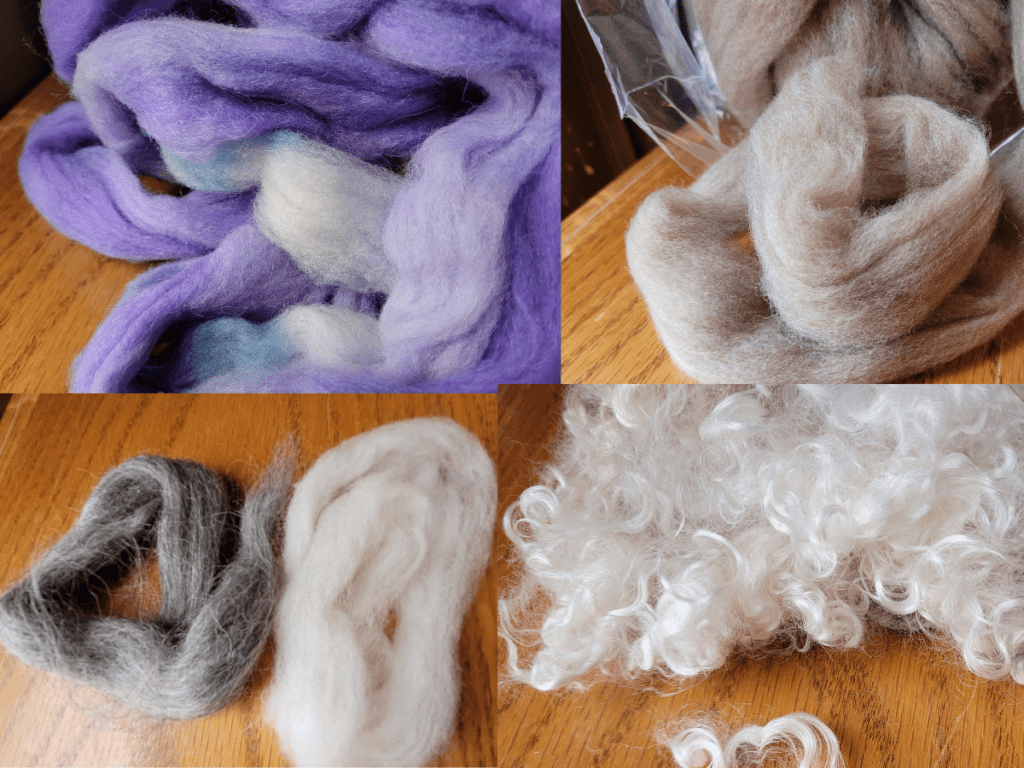
Looking for a great resource on which fiber to pick and how best to use it? Consider getting The Fleece And Fiber Sourcebook, filled with wonderful pictures and details on just about any wool you can find.
Do you plan to spin worsted or woolen?
Here is the main question, how do you plan to spin the wool? Are you going to be using a worsted technique, for a more defined yarn, or a woolen technique for a yarn with a bit more fluff for softness?
For worsted spinning consider longer staple length wools
To spin worsted, use a medium to long staple length wool. Keep your staple length over 3 inches, anything under that is going to be tough to work with.
I have noticed that I do better with more of a 3.5 inch minimum staple length.
For more details on working with longer stapled wools, read How Do You Spin Long Stapled Wool?
For woolen spinning, use shorter staple length wools
To spin woolen, choose shorter staple length wools to work with.
With woolen spinning, you are really working off of the cloud of prepared fiber and the wool crimp, meaning using a well prepared roving is key to woolen spinning.
Do you want your finished item to drape or spring back?
Whether your yarn is springy or not is more a function of crimp, which is build in to the wool from the get go.
If you want to make a soft, cozy hat that keeps you warm, consider a wool that will spring back into shape, which would be a higher crimp wool that is most likely spun woolen.
Choosing full of life wools will give you resilient yarns that will bounce back into shape. Something like Cheviot or Zwartbles would work well here.
On the other hand, choosing shiny wools that are super smooth will give you little to no bounce back in your finished project.
If you want something that will drape, like a scarf, consider a lustrous longer wool and, of course, spinning worsted. Something like Blue Faced Leicester is an easy choice for luster and drape.
Is your project for next to skin or outerwear?
Deciding if you want next to skin soft is a biggie, you a stuck with what you buy on this one.
If you want next to skin options, go with a fine wool, something that is less than 23 microns.
You can give the very fine medium wools a shot, maybe up to 25 microns or so, but this will all depend on the wearer.
Anything under 30 is considered next to skin soft, but for some folks 30 is not fine enough for them to enjoy wearing the garment.
In general, medium and long wools are not the ideal option for next to the skin fabrics.
If you are going for more of an outerwear project, like hats or a sweater, go with a medium or long wool for a longer lasting more durable yarn.
Of course, you can use a fine wool for outerwear or other projects like rugs, as long as you do not need the additional durability of a medium or long wool.
Do you want color, natural colored or dyed?
Are you looking for color in your wool? You have the options of naturally colored wool and dyed wool.
Naturally colored wools are wools that have color from the sheep. These wools are in earthy tones, from lightly tinted to a rich black and can be solid or variable throughout the fleece.
I love naturally colored wools, but not all breeds have naturally colored fleeces in their sheep, quite a few do, but not all.
This is The Woolery’s main protein fiber page, you’ll quickly see the naturally colored wool options available. Top of mind examples are Shetland, BFL, Comeback, Black Welsh Mountain and Zwartbles.
Expect to search around a bit if you are looking for an interesting naturally colored roving or fleece.
As far as dyeing goes, there is variability by breed in the wool’s willingness to take on dye. Some wools do not take dye well, whereas other wools are wonderful to dye. It all depends upon the wool.
Do you want the option to felt?
As a final consideration, do you want the ability to felt your wool, yarn or project?
Some wools felt astonishingly well, like Merino and Corriedale, other wools are very resistant to felting, like the down breeds.
When I first got started spinning I tried and tried to get my wool to felt.
I had heard all about how careful you have to be washing the wool and how you have to be on guard for felting at all times. My wool wouldn’t felt even when I tried!
What was the problem? The breed of sheep!
I was using wool from our sheep, which were mainly Dorset, a breed whose wool is resistant to felting.
I didn’t realize at the time what the problem was and spent a lot of frustrating hours trying to figure out what I was doing wrong.
Turns out I wasn’t doing anything wrong, as far as the mechanics of felting, I was starting out with the wrong wool for my purpose, which turned a fun idea into a huge source of frustration!
If you want to felt your wool anywhere along the lines of making the project, be sure that you are working with a wool that felts easily.
Most places you buy wool from will list out if the wool is good for felting projects in the description.
Handspinning for enjoyment
When it comes down to it, there really is no “have to” involved here. Handspinning is all about creativity and exploring, both materials and your abilities.
Get some wool you are interested in, make a few sample yarns and see how they perform.
I spin a small amount of a new to me wool, then make a test swatch and see how the wool knits up and what characteristics it has after I have spun it. Then I decide what project to make.
I really like to spin wool.
For me it’s all about the feel of the wool, trying different breed wools and seeing what colors do in the yarn, specifically natural colored fleeces. I knit to further explore and wear/use my spinning.
I have to admit, I like to spin worsted and like to make hats. From what I’ve written above, that is not going to work out, but it does because it’s how I like to do things and am okay with the results.
If I want to knit something different, I can change my ways! Or, I can do what I want and see what happens. That’s the beauty of wool craft and you have these options, too!
If you are trying to make something specific, you’ll need to spin the yarn that is required for the result you want. If you are just enjoying your spinning time, you can do as you please and see what shakes out.
If you are still wondering about all of the different fiber preparations, Paradise Fibers has an informative article, Roving and Sliver and Batts! Oh My! which is one of the best I have found so far, as far as comparing your options and having pictures of each.

